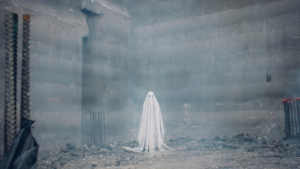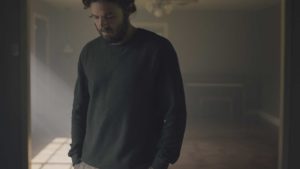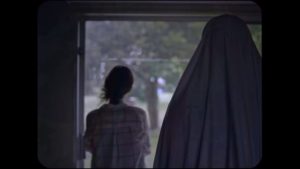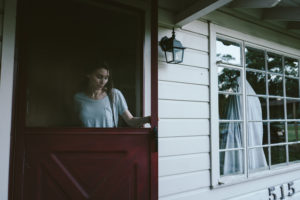Movie Review: A Ghost Story

About one third of the way into David Lowery’s supernatural drama A Ghost Story, the film’s heroine Rooney Mara (simply known as M) sits down at the end of her bed. She has just stripped it and is clutching the sheets meditatively. The realisation is both painful and poignant. Her recently departed husband Casey Affleck (referred to as C) had slept in these sheets. The mere act of washing them will bring about another degree of separation. The grievous loss, as suggested here by Lowery, couldn’t be any clearer – the most commonplace, everyday thing reminds us of the one who has been taken. In Mara’s case it is, presumably, the love of her life, who has had his own cut short much too soon. The couple appear to be happy in their single-storey house which they rent in the suburbs. He is a work-at-home musician. Mara’s role, on the other hand, is never exactly defined. One night an unmistakable thud on the piano awakens the couple. Affleck goes to explore it in his boxers; Mara shrouds herself in a bed sheet. But do not be deceived by this moment. A Ghost Story most definitely does not belong in the horror genre. It’s more akin to Spielberg’s 1989 Always, but without the glaring sentiment and the treacly dialogue. If anything, there is a distinct lack of the latter, treacly or otherwise. Killed in a tragic car collision, Affleck’s character is unable to speak at all. Clad in a white sheet, he returns home from the hospital morgue to apparently observe his wife’s period of mourning. A scene which precedes all of this suggests that he has an opportunity to pass on to the afterlife (represented here by a doorway of bright flashing light). But C decides not to avail of this. We ask ourselves if he has some unfinished business on earth. Does he somehow wish to resolve a matter of importance with M?

Produced on a shoe-string budget, A Ghost Story employs a sparse approach with respect to its storytelling and setting. In the main, the dramatic action (if we can even call it that) takes place in a single room – M and C’s kitchen come living room. Lowery first presents them to us holding each other in a tender embrace as they converse about an unspecified subject. Later on in a flashback, M reminds C of the necessity for communication in their relationship. She also enquires as to why he wishes to remain on in this house which isn’t even their own. Is he holding her back in some way? Or are his motivations dictated by some hidden force? The climactic scenes of A Ghost Story certainly suggest the latter in this regard, but, as with so much of this fine film, Lowery invites us the viewer to form our own opinion on such matters. The same can be said of a small piece of paper which M has tucked inside a crack in the wall prior to her departure from the house. Clearly she has written something on it and this is the reason for C’s (as a spectre now mind you) never-ending attempts to pry it out. How long he spends at this exactly cannot be estimated. Lowery’s treatment of time is one of the more distinctive features of A Ghost Story. We watch M leave the house repeatedly (presumably to work) as her life gradually returns to a pattern and semblance of normality. C watches her fixed in the same position each time. No more than a few seconds of screen time are expended, but the point Lowery is making about time is manifest. The device he employs here reminded me of the way Kubrick effected such rapid transitions in the latter moments of 2001: A Space Odyssey (I’m referring here to the scenes involving Keir Dullea as he observes older versions of himself). Following M’s departure, C roams about the house in no small distress we assume; when he turns around a single mother and her two small children have moved in. A few cuts are imposed by Lowery and we are seeing them in typical familial situations; a Christmas tree is decorated; the children play and argue in their room. Rooted to this location, C can only watch and wonder where his beloved M has gone to. Is she content in her new life? Has she begun to forget certain things about him?

C has learnt that he can move objects and cause lights to flicker and he takes out his pent-up frustrations in front of the terrified young family. Unsurprisingly, the house is soon deserted and he is alone again. A few moments later, however (think several years perhaps), and a party of hipsters have invaded. They dance and kiss as C – unseen and undetected – glides among them. At a table in the kitchen, a self-appointed prognosticator played by singer-songwriter Will Oldham speaks at length about humanity’s attempts to leave traces of itself behind and the utter futility of this. Citing the example of a writer writing a novel or – more immediately felt – Beethoven composing his Ninth Symphony, he foretells of how such artistic endeavours will finally count for naught. The universe will, in time, turn in on itself; knowledge, experience and love will be lost forever in this apocalypse. Lowery, of course, is moving into the realm of even bigger themes here. How can anything ever endure? The simple truth is that it cannot. A great many viewers will not appreciate A Ghost Story’s deliberate pacing and its lingering shots (the morgue in the hospital is one such); others of a religious bent of mind may very well take exception to the message that there might be no God as Oldham’s character suggests. Even if there is such a deity, the reflection is that continuity is not a given. If the universe ends, then so too does the length and breadth of the human narrative. We never had such musings in the aforementioned Always or 1990’s Ghost.

Lowery – who directed last year’s excellent Pete’s Dragon – is clearly a man on the rise and this is his second collaboration with both Affleck and Mara (2013’s Ain’t Them Bodies Saints being the previous one). Shot in a narrow format, A Ghost Story’s visual aesthetic gives the impression that the audience is an intruding third party gazing in upon these shattered lives. Let’s remind ourselves here that C – as the ghost – pines for his beloved as much as she does for him. Concealed by a white sheet for much of the film, and mute into the bargain, Affleck’s performance pivots on the movements of his body and the slightest inclines of his head. Mara – absent for most of the second half of the film – is given more free rein. A pie-eating scene which lasts for a number of minutes has already sparked much comment and debate. Personally, the matter which Lowery is attempting to emphasise here I think is the way in which the bereaved seek out solace or comfort to mitigate their pain. In M’s case, it’s a fruit pastry which she attacks with no small amount of aggression. Again, be prepared for some guffawing and sighing around you in the auditorium. A Ghost Story will not ring through with some viewers. More than a few will ask how such an apparently trivial scene has any relevance. But the truth of the matter is that it has, and Lowery’s film never takes a false step or descends into maudlin pondering. Instead, it’s an entirely valid meditation on life, loss, memories, mortality and – yes – love. In the lead roles, Affleck and Mara are as good as you would expect them to be. The original score by frequent Lowery collaborator Daniel Hart is suitably plaintive, yet never weepy. On writing, directing and editing duties, the Wisconsin-born filmmaker proves once again what a diverse talent he is. A Ghost Story is one of Lowery’s best films to date. Evocative and thought-provoking to the final frame, it will give the viewer much food for thought. How many films released during the summer season can make such a claim I ask you.
Rating: A